The Broke Backpacker is supported by you. Clicking through our links may earn us a small affiliate commission, and that's what allows us to keep producing free content 🙂 Learn more.
Want to know what the top 10 biggest deserts in the world are? We’ve compiled this ultimate list, along with the very best desert-themed tours to visit them on.
Deserts are defined as places that see less than 250 millimeters of rainfall a year (on average). There are 4 types; hot and dry, semi-arid, coastal, and cold.
Wild, untamed, and, well, deserted, they are some of the most beautiful landscapes on the planet. They are places that beg to be explored and invite only the most intrepid adventurers.
From the rolling sand dunes of Arabia to the frozen tundra of Patagonia, deserts have a home on every continent on earth. But the location of the largest desert in the world may just surprise you…
What Are Deserts?
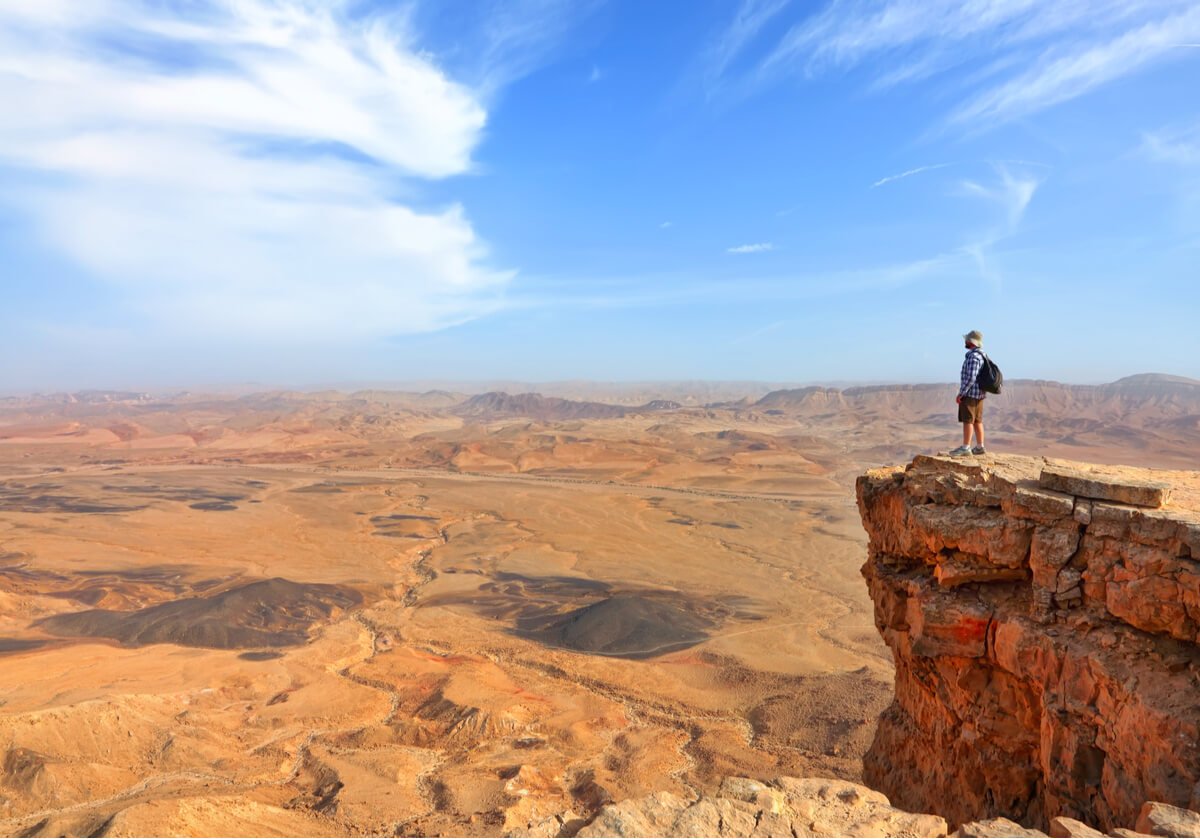
The Broke Backpacker is supported by you. Clicking through our links may earn us a small affiliate commission, and that's what allows us to keep producing free content 🙂 Learn more.
Deserts are desolate places defined by a lack of rain. When we imagine a desert, we often think of heat, sand dunes, and cacti. But deserts can be cold places too.
Some of the largest deserts on earth contain snow and ice, these sterile spaces are even more uninhabitable than hot deserts. But the thing they have in common is drought.
Parts of the Atacama, the driest (non-polar) desert on earth, see just 1 mm of rainfall a year according to NASA. Some river beds are thought to have been bone-dry for over 120,000 years.
Deserts can be found in almost every corner of the world. In fact, an astonishing 33% of Earth’s landmass is classified as desert land. And this figure is only increasing with climate change.
The Top 10 Biggest Deserts In The World
But where are the biggest? These 10 deserts outdo all others in size and scale, making them the largest on earth.
Antarctic Desert
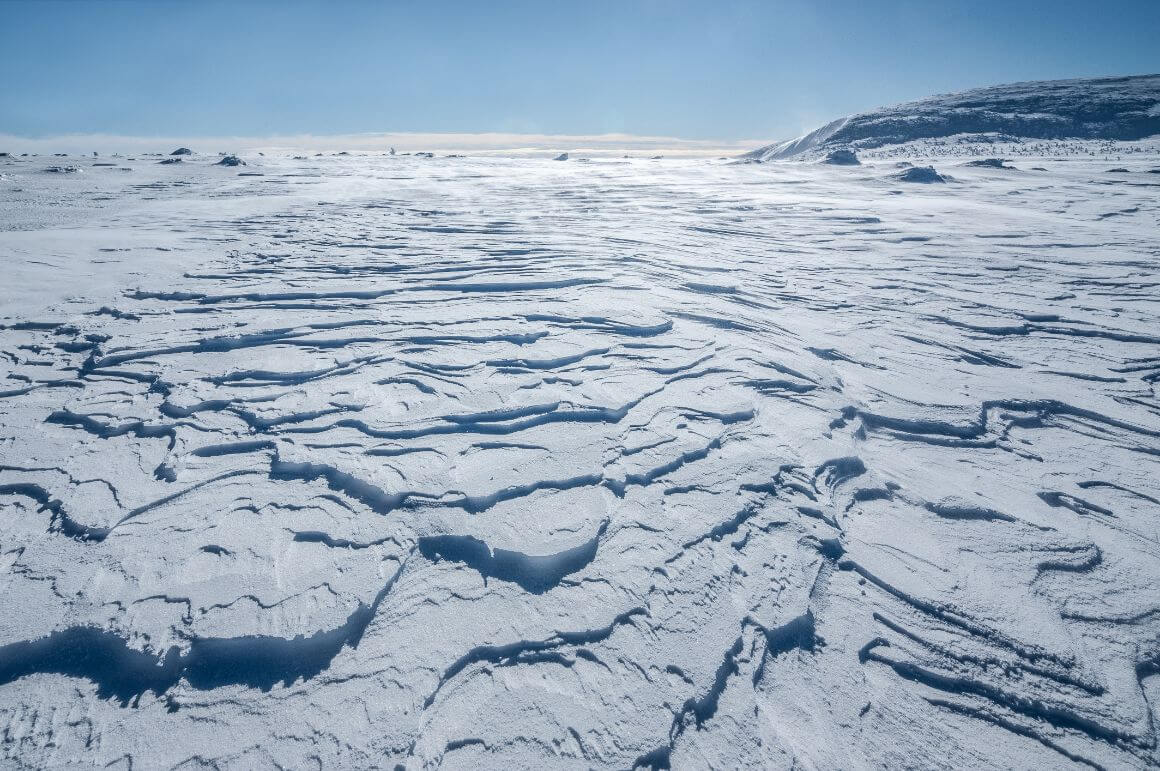
- Size: 14,200,000 km²
- Location: Antarctica
That’s right. The world’s biggest desert isn’t hot at all, in fact, it’s the coldest place on earth with record temperatures of -93.2°C!
This vast desert covers almost the entire continent of Antarctica. It’s believed that a staggering 98% is permanently covered by ice. Categorized as a polar desert, it only gets 10 mm of rain a year on average. Not much survives here other than bacteria, mosses, and lichens.
The coastal regions however are alive with marine species like seals, sea lions, sea birds, and vast colonies of penguins.
It’s a dangerous place where only intrepid explorers and scientists ever make it past the sea ice. But tourists with deep pockets can reach the outer rims with specialist icebreaker vessels.
Though many of us will never be able to take a cruise to Antarctica, you can get a taste of this remote continent from South America’s most southerly point.
Take a 10-hour sailing trip from Punta Arenas off the icy tip of Chile, one of the closest points to Antarctica. You can visit enormous glaciers up close, and expect to see whales, seals, and penguins.
Arctic Desert
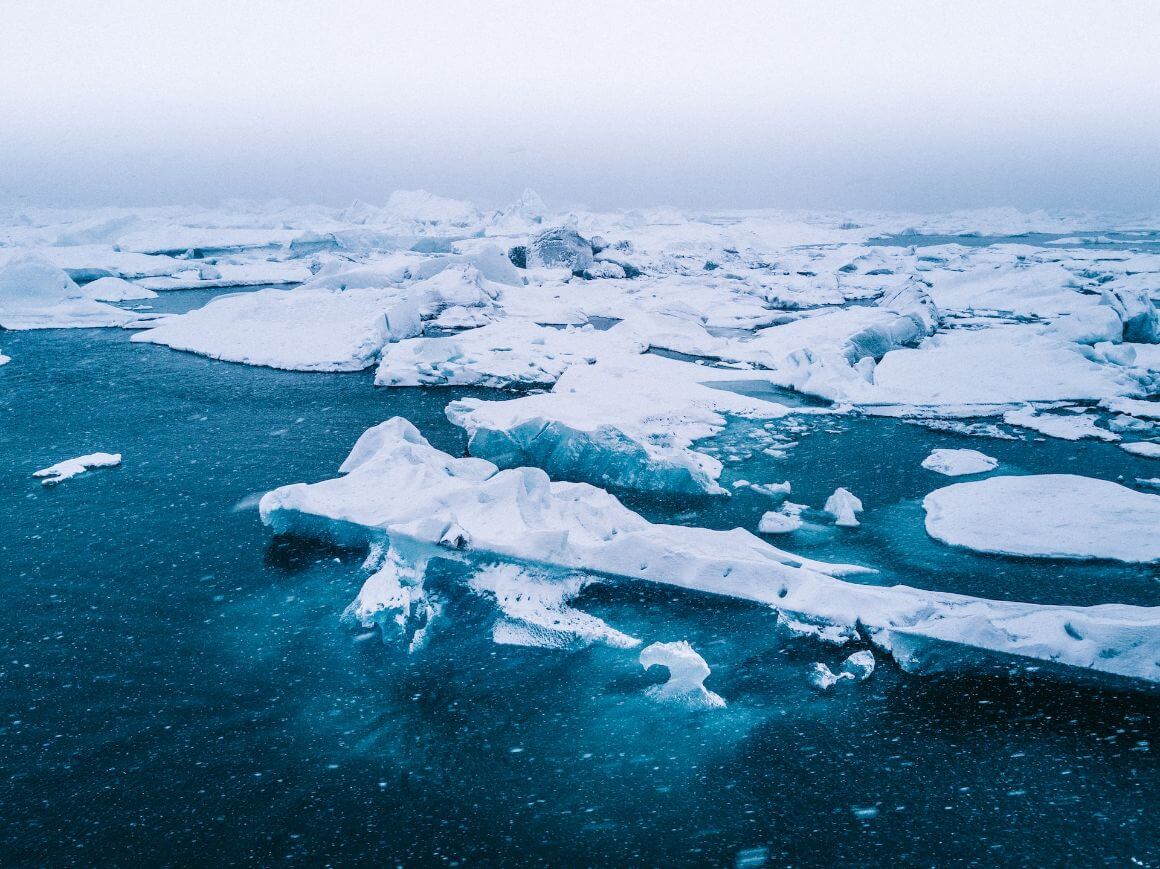
- Size: 13,900,000 km²
- Location: Eastern Europe, Northern America, Northern Asia, Northern Europe
- Countries: Canada, Finland, Greenland, Iceland, Jan Mayen, Norway, Russia, Svalbard, Sweden, and the United States
The only other polar desert in the world is on the other side of the planet. The barren Arctic tundra expands into countries like Canada, the US, and Russia.
It’s a lot easier to visit than its southern cousin as humans inhabit many parts of this landscape.
The permanently frozen blanket of snow means there is little rainfall here. Winter is bleak, with perpetual darkness, while in summer it’s known as the land of the midnight sun.
Vast primeval forests, permafrost, and lakes with thick ice are the main features of the landscape in this part of the world.
The wildlife here has adapted to the cold climate and harsh environment. The walrus, caribou, Arctic fox, snowy owl, and polar bears are some of the most famous residents.
It’s thought that around 4 million people have made a home across the Arctic region. The most well-known are the Saami people of Northern Europe and Northwest Russia, and the Inuit tribes of North America.
One of the best places from which to explore the Arctic is Norway. With the lure of the Northern Lights, Tromso has become a hub for exploring the Arctic Circle.
Take a Lapland Husky Sled Safari from Tromso to take in the otherworldly sights of icy landscapes and frozen forests.

Do You Want to Travel FOREVER??
Pop your email in below to get a FREE copy of ‘How to Travel the World on $10 a Day!’.
Sahara Desert
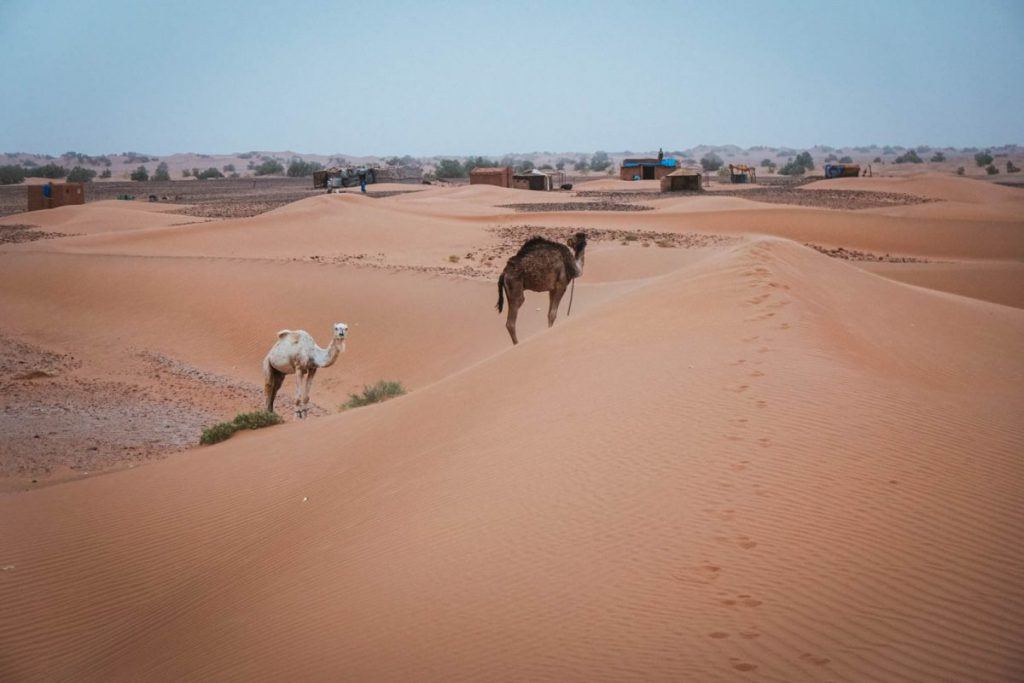
- Size: 9,200,000 km²
- Location: Eastern Africa, Middle Africa, Northern Africa, Western Africa
- Countries: Algeria, Chad, Egypt, Eritrea, Libya, Mali, Mauritania, Morocco, Niger, Sudan, Tunisia, and Western Sahara
“So, what’s the world’s biggest desert that is made of sand?” I hear you ask. The answer is the Sahara Desert in Northern Africa.
The largest subtropical desert in the world covers nearly a third of Africa.
It has everything you want from a desert: Scorching temperatures, bad-tempered camels, and towering sand dunes that reach as high as 183 meters!
Whilst dehydration is one of the most dangerous things in the Sahara, you also need to keep an eye out for the wildlife. Snakes, lizards, and scorpions are often found lurking in the dunes.
Though life seems impossible here, there are 20 seasonal lakes and 2 rivers; the Nile and the Niger. These rivers and desert oases provide a safe haven for the animals and people scattered throughout the Sahara.
To get a real sense of how extreme life is here you need to stay in the desert overnight. A popular starting point is Marrakech in Morocco.
From the city, jump on a 3-day Sahara tour to Merzouga Erg Chebbi. You will get to see Ait Ben Haddou, visit the Valley of the Roses, explore the Atlas Mountains and climb the Erg Chebbi dunes near the border with Algeria.
Australian Desert
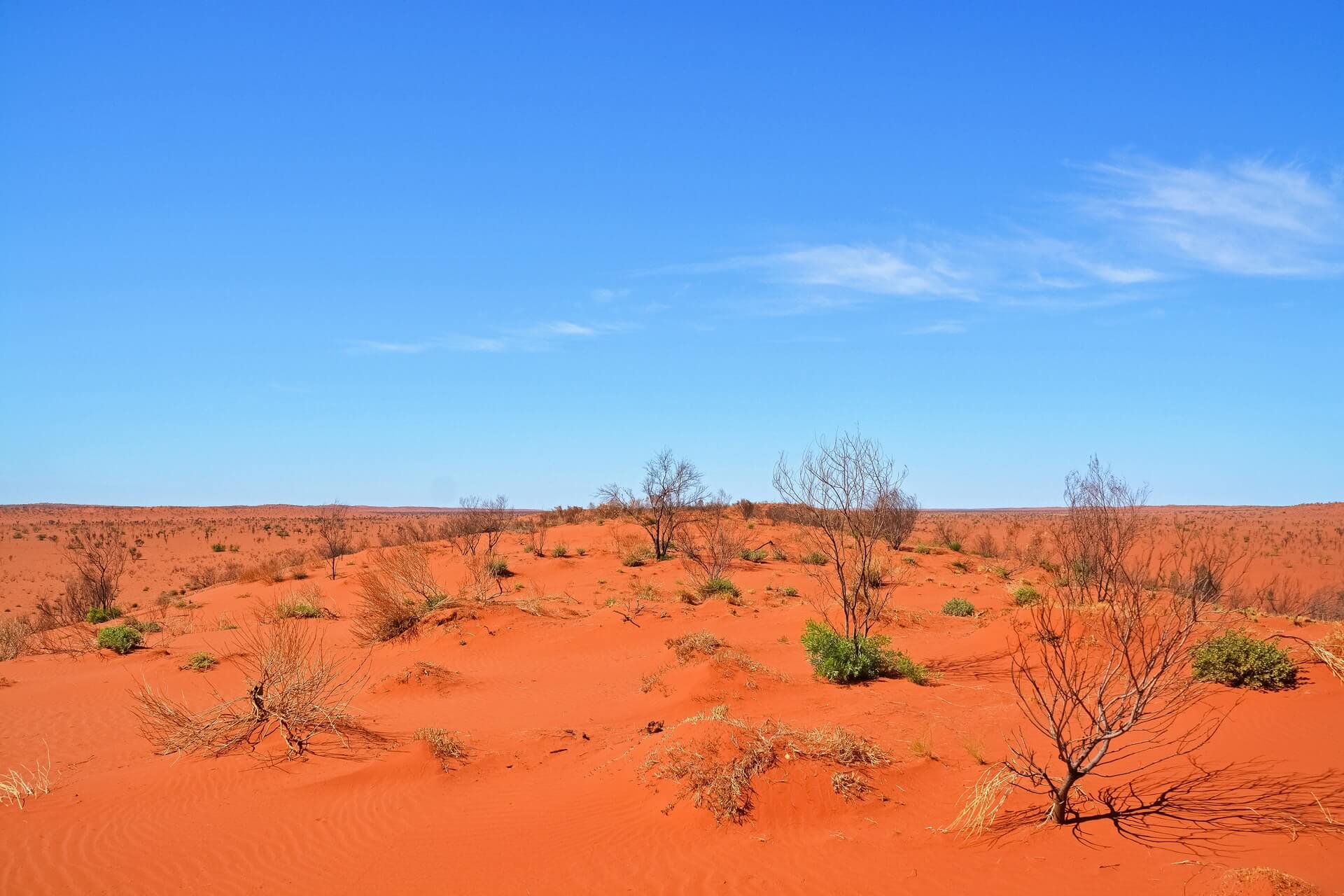
- Size: 2,700,000 km²
- Location: Australia
The parched ‘red center’ of Australia makes it the driest inhabited continent on earth. In fact, 70% of the country is arid, with just 500mm of rain per year.
The Great Australian Desert is actually made up of 10 individual deserts, the largest being the Great Victoria and the Great Sand Desert.
Australia’s barren lands are far from deserted, here you can find bandicoots, kangaroos, bats, dingoes, and plenty of reptiles.
Although camels aren’t native to Australia, the wild camel population here is the biggest in the world. Introduced in the 1800s as a way to cross the desert safely, there are now around 750,000 camels roaming wild in the outback.
The Gibson Desert Nature Reserve holds the largest population of aborigines in Australia. But most visitors to Australia will choose to stop off at Uluru, to visit the huge sandstone monolith in Uluru-Kata Tjuta National Park.
Do more than just a photo stop at Uluru when visiting the Australian Desert. This small group tour to Kata Tjuta takes in sunrise views over the ‘Olgas’, 36 beautiful rock formations that rival the main attraction. Have an outback picnic breakfast while taking in the colors of the burnt-orange earth, then head off on a walking tour of Walpa Gorge.
Arabian Desert
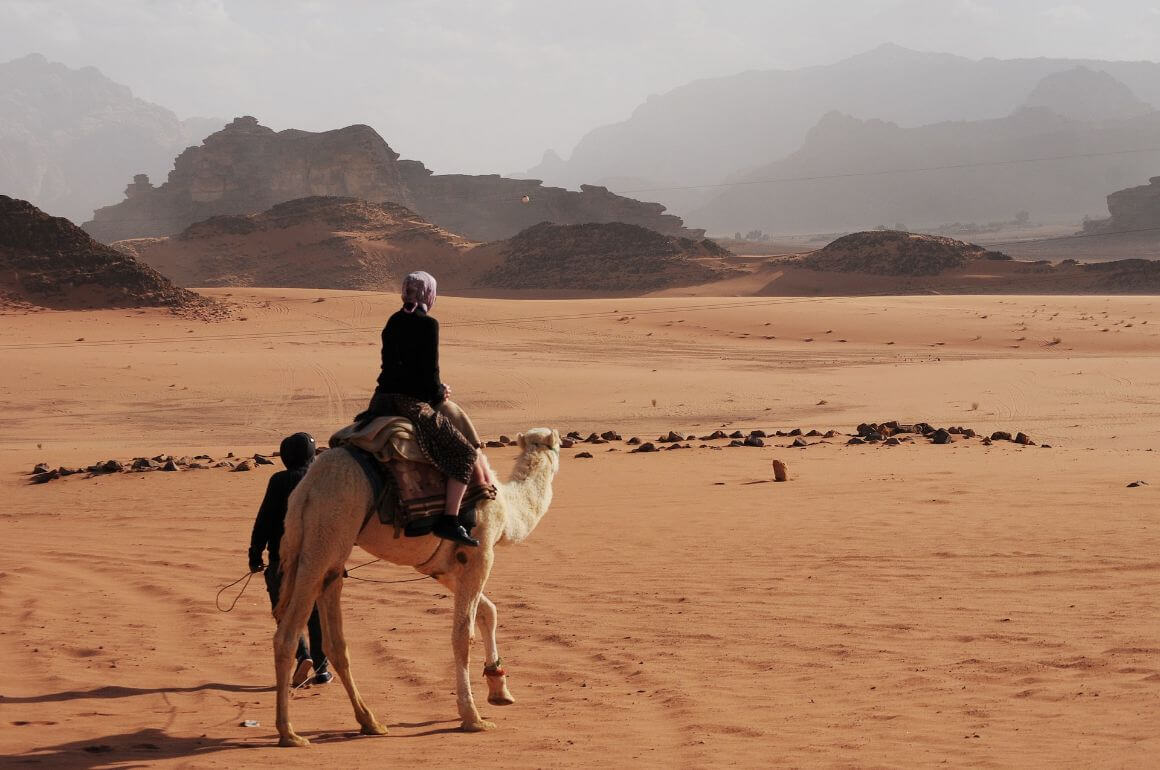
- Size: 2,330,000
- Location: Western Asia
- Countries: Iraq, Jordan, Kuwait, Oman, Qatar, Saudi Arabia, the United Arab Emirates, and Yemen
Spanning most of the Arabian Peninsula in Asia, the sparsely populated desert interior records temperatures up to 50° C during the day.
In the north, Nafud’s giant sand dunes reach 120 meters high. While Rub’al Khali in the south, known as the ‘Empty Quarter’, is the largest dune desert in the world at 650,000 km².
Although much of the land is devoid of life, it is rich in natural resources like oil and sulfur. Wildlife includes gazelle, the oryx, the locust, and the dung beetle.
Nomadic tribes like the Bedouin have herded their animals across these vast expanses for centuries. Living off of their knowledge of the land and herds of camels, sheep, goats, or cattle.
But their way of life is dying out, with just 5% now living semi-nomadically. Tourism is one of the few things keeping the culture alive.
Head out on a desert safari from Dubai to experience life in the Lahbab Desert, spending time at the Al Khayma Camp.
Activities include sandboarding, dune bashing, quad biking, and a leisurely camel ride. In the evening, tuck into a buffet with three cuisines, including Emirati, Moroccan, and Arabian.
Gobi Desert
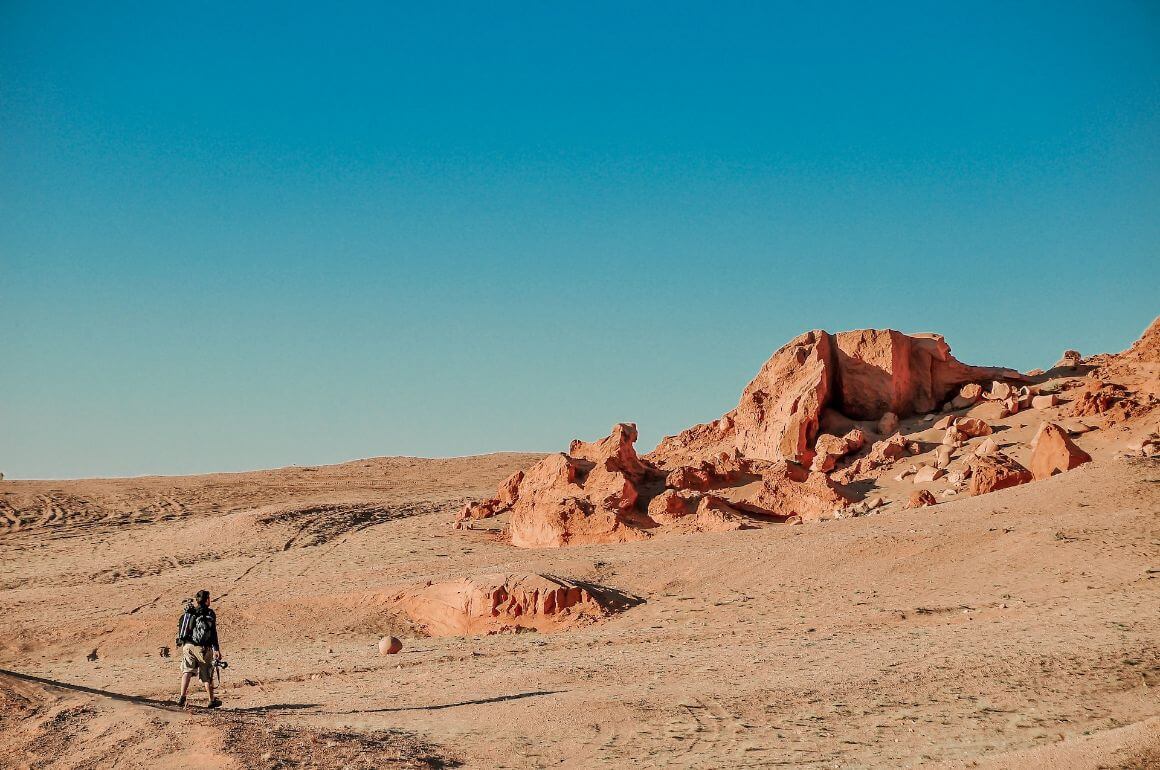
- Size: 1,295,000 km²
- Location: Eastern Asia
- Countries: China and Mongolia
One of the most famous deserts of the world, the Gobi is the stuff of legends. The great Gengis Khan once ruled these harsh lands, uniting the nomadic tribes of the Mongol empire.
The semi-arid desert mainly consists of rock and hard-packed earth, making it the perfect trade route as part of the Silk Road.
Goods and cultural advancement passed from East to West and back through seemingly impenetrable terrain like the Gobi Desert and the Pamir Mountains.
Marco Polo, a merchant from Venice, journeyed on the Silk Road to China before his stay at Kublai Khan’s palace at Xanadu. He was the first European to see much of the Gobi Desert and the Mongolian Plateau.
The desert nowadays is relatively accessible to everyone, with the Trans-Mongolian railway line cutting right through the Gobi.
The wildlife in the Gobi is as diverse as the landscape with Bactrian camels, Gobi bears, snow leopards & wild sheep all scraping out an existence.
Top sights include the fossilized dinosaur eggs at the Flaming Cliffs of Bayanzag, Yolyn Am Ice Field, and Gobi Gurvansaikhan National Park.
This 4-day Mongolia Gobi Desert tour takes in all of the best sights, with return transportation from Ulaanbaatar. Sleep in a traditional Mongolian Ger, visit a camel herder and eat local meals on this off-the-beaten-track tour.
Kalahari Desert
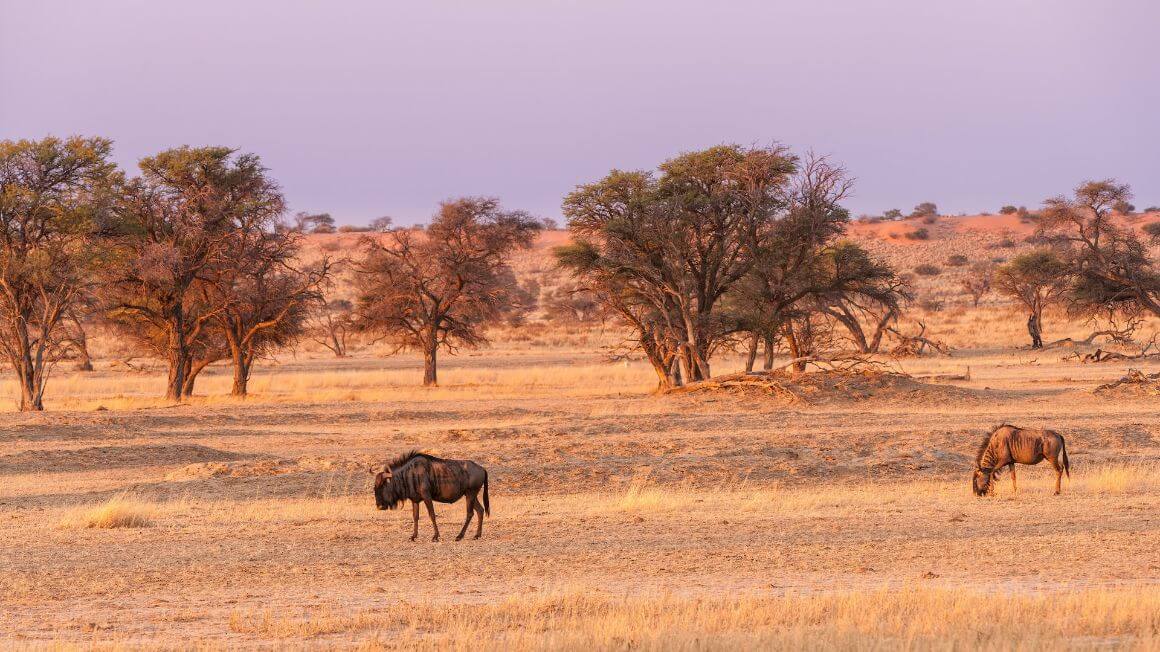
- Size: 900,000 km²
- Location: Southern Africa
- Countries: Botswana, Namibia, and South Africa
Another of the most famous deserts of the world, the Kalahari boasts amazing wildlife, rich resources, and a surprising amount of rainfall.
It’s actually classed as a semi-desert as it receives around 8 inches of rain per year (much of it passes straight through the sand). The Okavango River collects water on its journey through the desert to the Okavango Delta, the world’s largest inland river delta.
Many of Africa’s big mammals can be found in the Central Kalahari Game Reserve – the second-largest animal reserve in the world.
Common wildlife sightings include antelope, elephants, giraffes, meerkats, hyenas, and huge numbers of wildebeest.
People have also made a home here, the Khoisan are a fusion of the tribes Khoi (herders) and San (hunter-gatherers). They speak the rare Taa dialect, interesting for having more vowels and consonants than any other language.
The Kalahari Desert, translating to ‘great thirst’ in Tswana, is rich in nickel, copper, and coal, as well as being home to one of the biggest diamond mines in the world.
This 12-day small group safari covers the best things to see in and around the Kalahari. Travel to the Moremi Game Reserve, the Okavango Delta, Chobe National Park, and the spectacular Victoria Falls.
Patagonian Desert
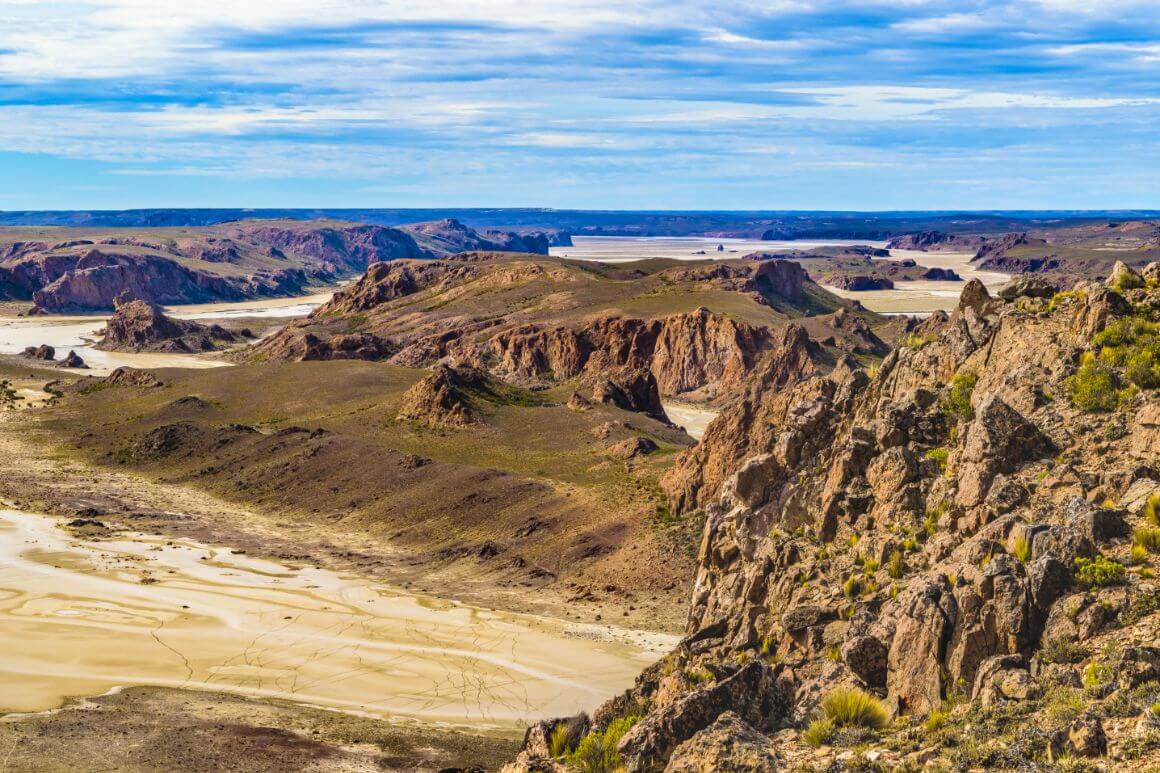
- Size: 673,000 km²
- Location: South America
- Countries: Argentina
The largest desert in South America lies between the colossal Andes mountain range in the west and the Atlantic Ocean to the east. Patagonia is perhaps best known as the setting of the most intense stages of the Dakar Rally from 2009 to 2019.
The semi-arid Patagonian Desert is at the southern tip of the civilized world. Battered by freezing winds, it’s a harsh place where the weather can change in an instant.
The temperature rarely exceeds 12 °C, and averages just 3 °C. There are 7 months of winter and just 5 months of summer, making it hard for any life to survive. The rain shadow created by the Andes also means there is little precipitation.
Wildlife on the steppe includes guanaco, puma, Patagonian fox, burrowing owl, and rhea. While on the coast the cute Magellanic penguin steals the show.
One of the most visited sights is Los Glaciares National Park. It’s home to the massive Perito Moreno Glacier, the third-largest reserve of freshwater in the world. One of the few glaciers on earth that isn’t shrinking, instead it moves forward by up to 2 meters a day.
Cross the Patagonian Steppe on a native cultures 4×4 excursion from El Calafate, Argentina. Discover rock paintings, and unwrap the history of the indigenous Tehuelche culture as you explore the incredible landscapes around Los Glaciares National Park.
Syrian Desert
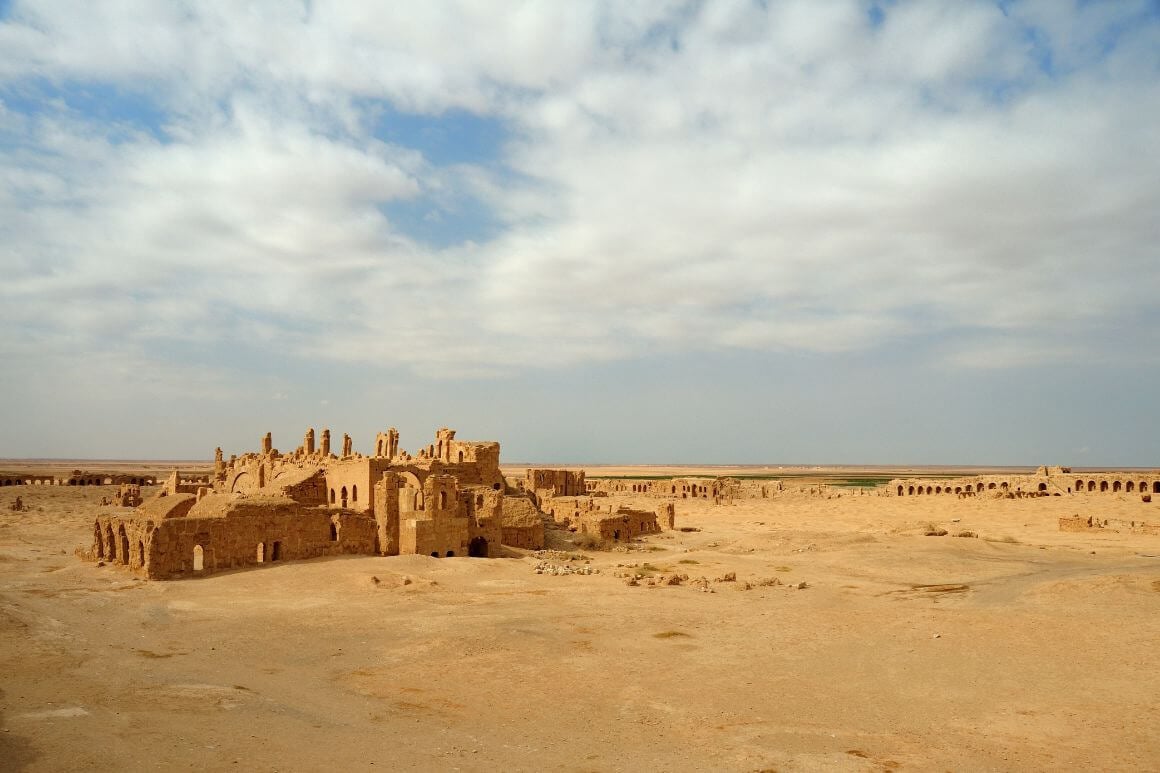
- Size: 500,000 km²
- Location: Western Asia
- Countries: Iraq, Jordan, Saudi Arabia, and Syria
Perhaps one of the least famous deserts in the world, the Syrian Desert still has a lot to offer. Also known as the Jordanian Steppe, the majority of the desert actually lies in the beautiful country of Jordan.
The Syrian Desert’s natural boundaries are formed by the Euphrates River, the Orontes Valley, and the Arabian Desert to the south.
Wildlife includes gazelles, jerboas (a rodent with comically large ears), sand foxes, wolves, Monitor lizards, chameleons, vipers, and scorpions.
Like the Arabian Desert, the Bedouin people have lived here for generations. Large cities in the desert, like Damascus and Palmyra, are made possible due to fertile oases. Unfortunately, the Iraq War and the Syrian Civil War have made Syria dangerous to travel to. But you can safely visit Jordan.
The vast ancient city of Petra is one of the New Seven Wonders of the World, and you’ve probably seen the red desert of Wadi Rum in films like The Martian and Lawrence of Arabia.
Take a jeep tour to Wadi Rum and camp overnight in a cave. The lack of light pollution means it’s one of the best places to see stars on the planet.
Chihuahuan Desert
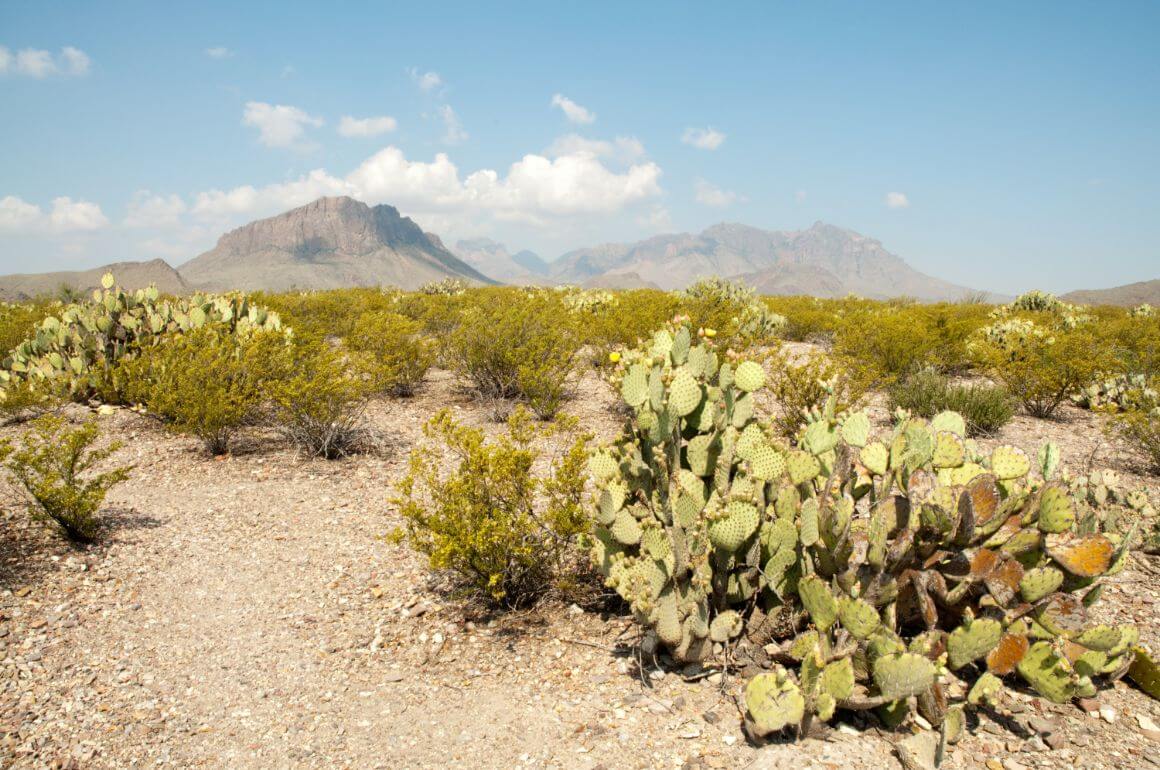
- Size: 453,248 km²
- Location: Northern America
- Countries: Mexico and the United States
Sharing a border with the United States and Mexico, the Chihuahuan Desert is the largest in North America.
It’s semi-arid due to its elevation making it cooler and moister than most deserts; its plains range between 3,00 and 5,000 feet.
The Desierto de Chihuahua, as it’s known in Spanish, has hundreds of animal species some of which are endemic to the region. It also contains around 3,500 plant species and 400 different species of cactus!
Wildlife spotting opportunities include golden eagles, mountain lions, bobcats, wolves, coyotes, prairie dogs, and tarantulas.
Although 90% of the Chihuahuan Desert lies in Mexico, the most famous place to visit is in Texas at Big Bend National Park.
Paddle along the Rio Grande River as you take in views of the Chihuahuan Desert. This canyon float tour sets out from Terlingua, Texas, on a relaxing full-day adventure along the river.
You will learn heaps about the wildlife, cultural history, and geology of the Chihuahuan Desert from an expert local guide.
FAQ About Biggest Deserts In The World
Final Thoughts
So there we have it, the top 10 biggest deserts in the world. Whether you are looking for epic adventures on the dunes, crossing ice fields by sled, or learning about ancient nomadic cultures, deserts are some of the most diverse places to explore on the planet.
But if it’s bragging rights you’re after, you really can’t beat a trip to the Sahara. The queen of deserts (and we don’t mean Priscilla), is a once in a lifetime experience for any traveler.
ALWAYS sort out your backpacker insurance before your trip. There’s plenty to choose from in that department, but a good place to start is Safety Wing.
They offer month-to-month payments, no lock-in contracts, and require absolutely no itineraries: that’s the exact kind of insurance long-term travellers and digital nomads need.
SafetyWing is cheap, easy, and admin-free: just sign up lickety-split so you can get back to it!
Click the button below to learn more about SafetyWing’s setup or read our insider review for the full tasty scoop.
Buy Us a Coffee!
A couple of you lovely readers suggested we set up a tip jar for direct support as an alternative to booking through our links, since we’ve decided to keep the site ad-free. So here it is!
You can now buy The Broke Backpacker a coffee. If you like and use our content to plan your trips, it’s a much appreciated way to show appreciation 🙂









